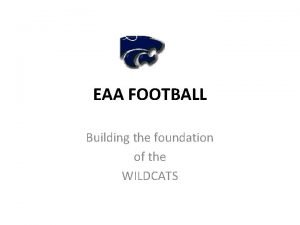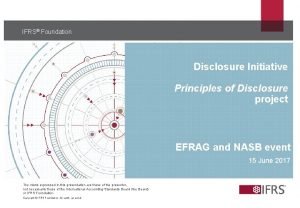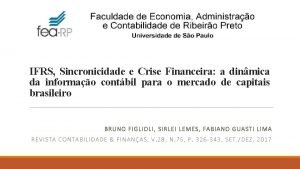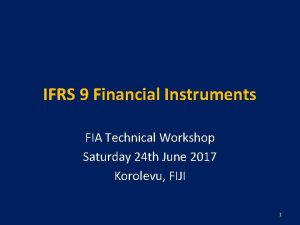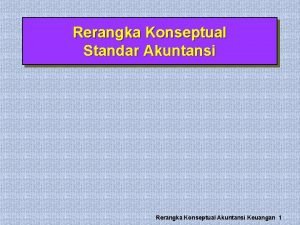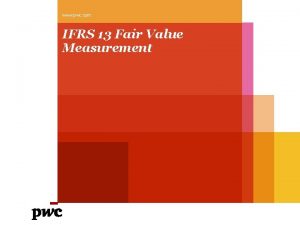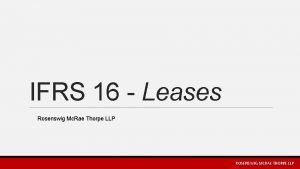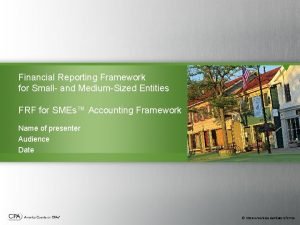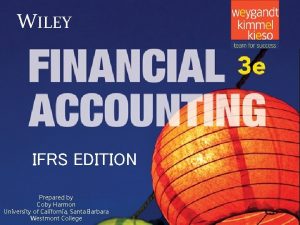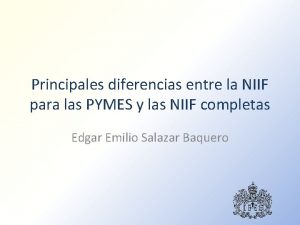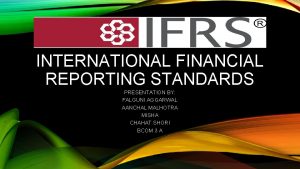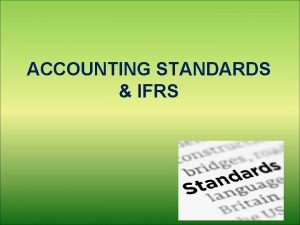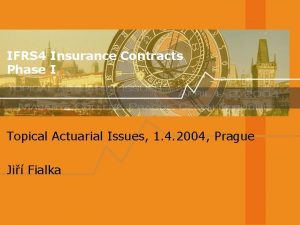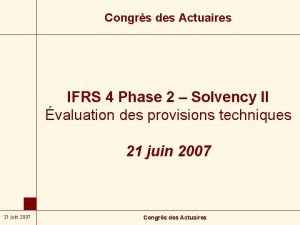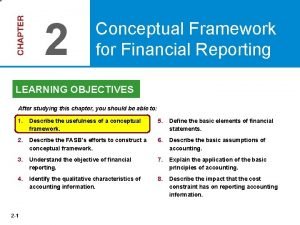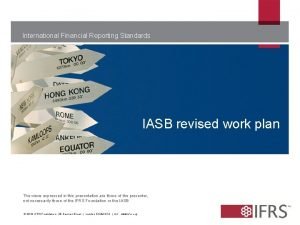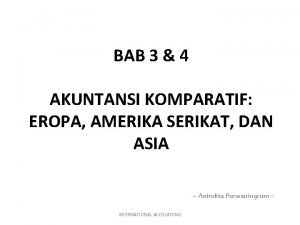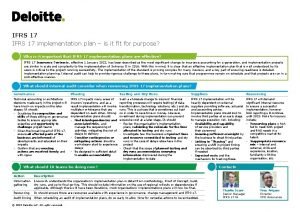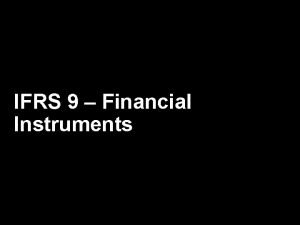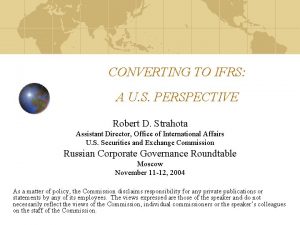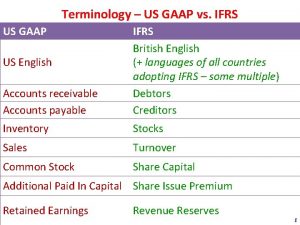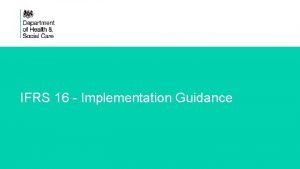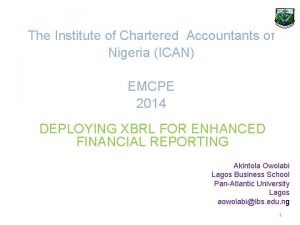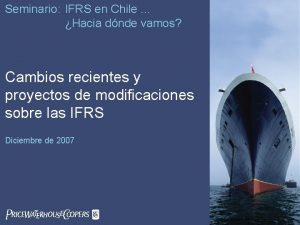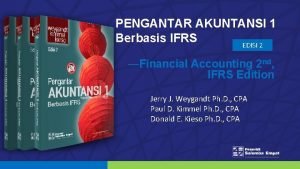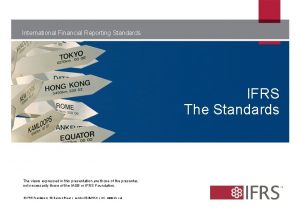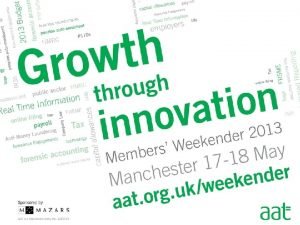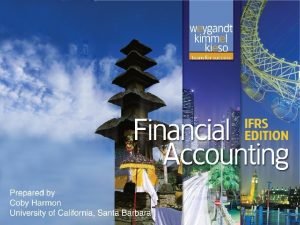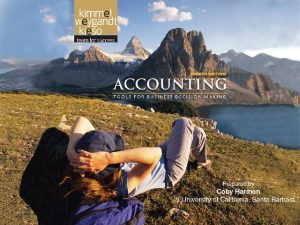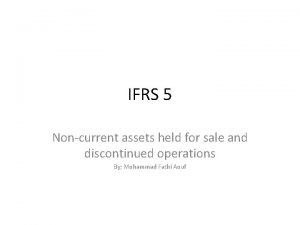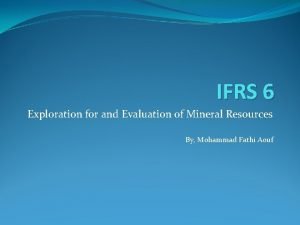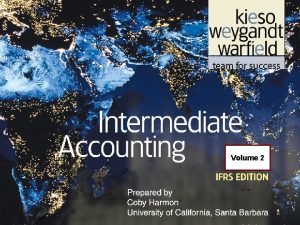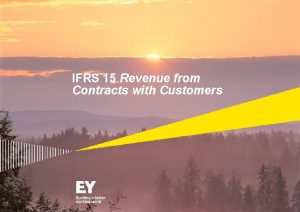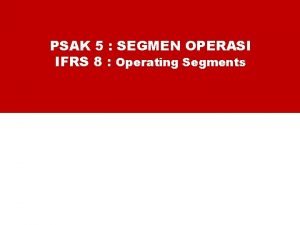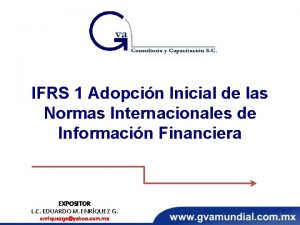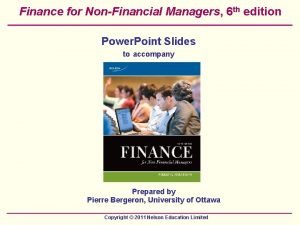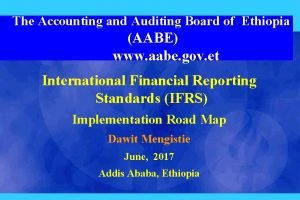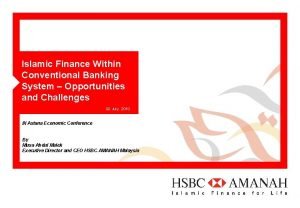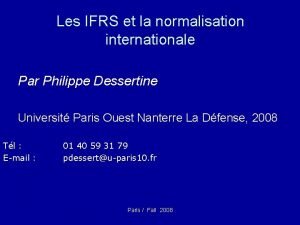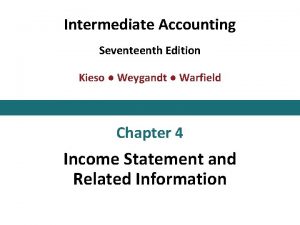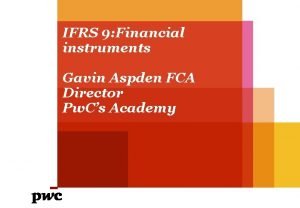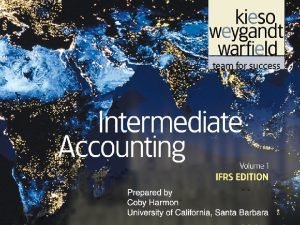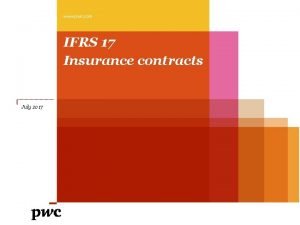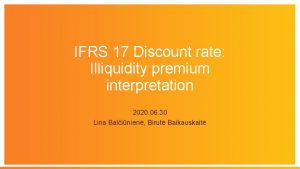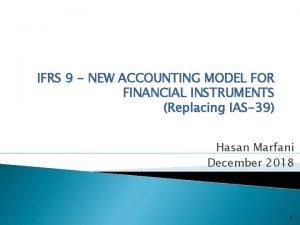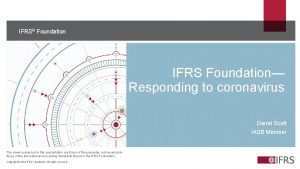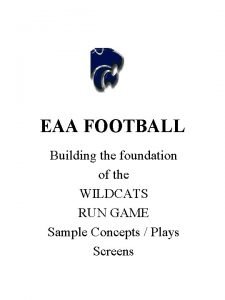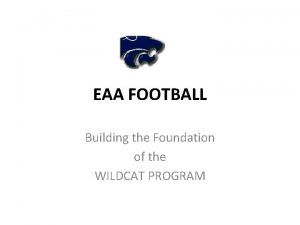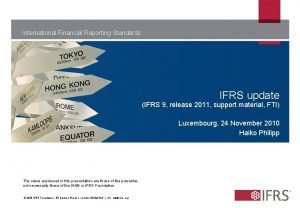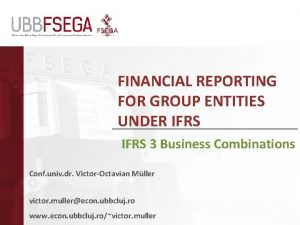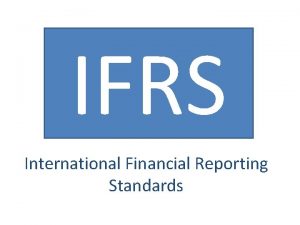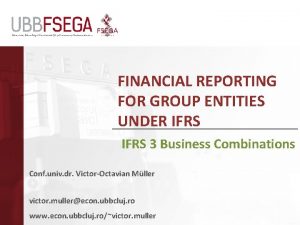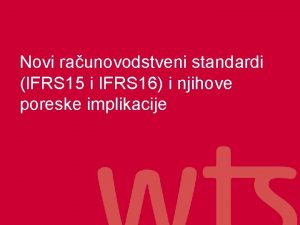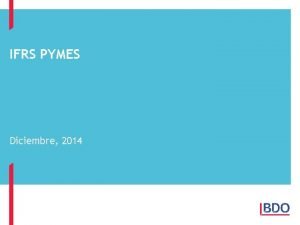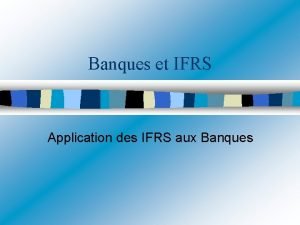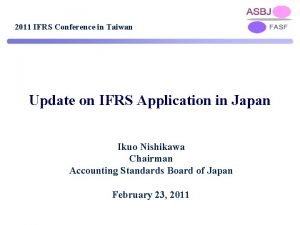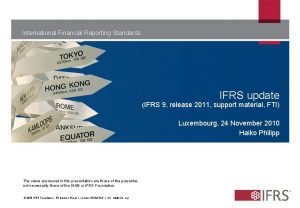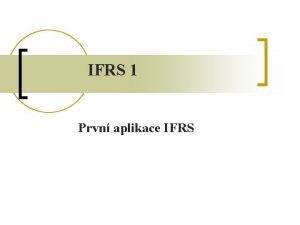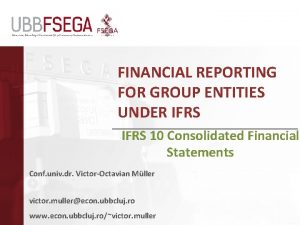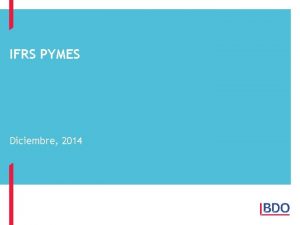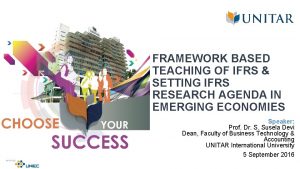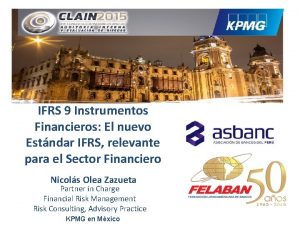IFRS Foundation 1 IFRS Academic Workshop EAA Annual



















































- Slides: 51

IFRS® Foundation 1 IFRS Academic Workshop EAA Annual Congress Milan 30 May 2018 The work of the IASB Update on the work of the IASB - May 2018 Ann Tarca IASB Board Member The views expressed in this presentation are those of the presenter, not necessarily those of the International Accounting Standards Board (the Board) or IFRS Foundation. Copyright © IFRS Foundation. All rights reserved

Contents • Better Communication • Management Commentary • The Research programme – – Financial Instruments with Characteristics of Equity Business Combinations under Common Control Dynamic Risk Management Goodwill and Impairment • Post Implementation Reviews • Implementation Support Activities • Resources and communications 2

IFRS Foundation 3 Better Communication Copyright © IFRS Foundation. All rights reserved

Central theme of the Board’s work 4 Better Communication in Financial Reporting Primary Financial Statements Disclosure Initiative Content and its organisation IFRS Taxonomy™ Content delivery

Better Communication Report Purpose • Demonstrate that better communication is possible • Inspire others to improve communication Content • Focuses on the seven principles of effective communication from the Principles of Disclosure Discussion Paper • Shows how entities disclosed information before and after enhancing communication in their financial statements • Describes how entities improved the way they communicate (the process) 5

Disclosure Initiative projects 6 Disclosure Initiative Research project Completed projects Amendments to IAS 1 to remove barriers to application of judgement Amendments to IAS 7 to improve disclosure of liabilities from financing activities Materiality Practice Statement Principles of Disclosure Maintenance projects Targeted Standards-level Review of Disclosures Definition of Material

Materiality Practice Statement 7 IFRS Practice Statement 2 Making Materiality Judgements Gathers in one place all the requirements on materiality from IFRS Standards and adds practical guidance and examples Objective Provides reporting entities with guidance on making materiality judgements when preparing financial statements in accordance with IFRS Standards Form of the guidance The Practice Statement does not change any existing requirements nor introduce any new requirements; it is a nonmandatory document developed by the Board

IFRS Foundation 8 Primary Financial Statements Copyright © IFRS Foundation. All rights reserved

Primary Financial Statements—project scope Statement(s) of financial performance Statement of cash flows EBIT subtotal ‘income/expenses from investments’ category Guidance on presentation of management performance measure and alternative EPS Considering better ways to communicate OCI removing options for presentation of income and expenses eg presentation of profit of associates/JVs Eliminating classification options (interest/dividends) (Not) aligning the operating section between statement of cash flows and statement(s) of financial performance Specifying the starting point for the indirect method ü Developing templates for the Primary Financial Statements ü Achieving greater disaggregation including minimum line items 9

Primary Financial Statements—project scope Not in the Scope of this project: Statement of financial position Statement of changes in equity No planned change, except for templates and greater disaggregation Financial Instruments with Characteristics of Equity project looks at some issues 10

IFRS Foundation 11 Principles of Disclosure Copyright © IFRS Foundation. All rights reserved

Principles of Disclosure— the disclosure problem 12 • The Board has identified three main concerns about disclosures in financial statements: – not enough relevant information – too much irrelevant information – ineffective communication Enabling preparer judgement Improved disclosure requirements Improved disclosures & better communication

Principles of Disclosure—next steps 13 • The Board: – added a project to review disclosures in specific Standards – will perform further research and analysis on: Topics specifically considered in the Discussion Paper Accounting policies to disclose Other topics highlighted by respondents Effect of technology and digital reporting • Location of information • • Materiality IFRS information outside the financial statements Non-IFRS information inside the financial statements Consider the practical effect of recent publications such as the Materiality Practice Statement

Principles of Disclosure 14 • The Board decided: The Primary Financial Statements project should consider • roles of the primary financial statements and the notes • presentation of EBIT and EBITDA • presentation of unusual or infrequently occurring items • fair presentation of performance measures The following topics unlikely to contribute significantly to addressing the disclosure problem • use of formatting in the financial statements • location of accounting policy disclosures • location of disclosure objectives and requirements in IFRS Standards • use of ‘present’ and ‘disclose’ in IFRS Standards

Targeted Standards-level Review of Disclosures 15 Develop guidance for the Board itself to use when developing and drafting disclosure requirements ce n a uid g e ov d r p Im e Boar h for t Identify one or two IFRS Standards on which to test the guidance for the Board Test the guidance for the Board by applying it to the test Standard(s) Prepare an Exposure Draft of amendments to the disclosure requirements of the test Standard(s)

Targeted Standards-level Review of Disclosures Guidance for the Board • Will be developed as a set of Board decisions • Formal stakeholder feedback will be obtained when subsequently used as part of standard-setting Test the guidance for the Board • The objective of the targeted standards-level review will be to improve the disclosure requirements and hence, the usefulness of the disclosures provided to the primary users of financial statements • The objective will not be to change the volume of disclosure requirements, although this may be a consequence 16

IFRS Foundation 17 IFRS Taxonomy Copyright © IFRS Foundation. All rights reserved

The IFRS Taxonomy 18 Reflects the presentation and disclosure requirements of IFRS Standards (including IFRS for SMEs Standard) and related common reporting practice in a timely and accurate manner Consists of ‘elements’ that are used by preparers to tag the information in IFRS financial statements Makes IFRS disclosures more accessible to users of structured electronic data Facilitates communication between preparers and users

The IFRS Taxonomy—areas of focus Common reporting practice Implementation support IFRS 13, Fair Value Measurement Update to materials, such as Using the IFRS Taxonomy—A preparer’s guide Research XBRL fillings to identify additional common practice elements Implementation guidance for specific elements 19 Entity-specific disclosures Working with XBRL International to improve accessibility of entity -specific disclosures in a structured report The impact of new or amended IFRS Standards on the IFRS Taxonomy in the next 12 months is expected to be limited

IFRS Foundation 20 Management Commentary Copyright © IFRS Foundation. All rights reserved

Scope of the Board’s interest Wider Corporate Reporting Public Policy Reporting(1) Other Financial Reporting (3) Financial Reporting Financial Statements Other Stakeholder Reporting(2) ‘Other financial’: information outside the financial statements that assists in the interpretation of a complete set of financial statements or improves users' ability to make better economic decisions. Management commentary: a narrative report that provides financial and non-financial information useful to users of financial reports Integrated Reporting Framework and national narrative reporting frameworks, along with a number of subject (2) Other frameworks (eg GRI Sustainability Reporting matter (e. g. Carbon Disclosure Standards Board) and sector Standards) and regulation address the needs of a wider based (e. g. Sustainability Accounting Standards Board) community of report users frameworks, also target this space (1) Reporting to support public policy objectives 21 (3) International

Reasons for updating the MCPS Growing importance of intangible business resources & relationships Proliferation of requirements with diverse objectives Incorporate relevant developments from other frameworks Close gaps in existing practice 22 MCPS update Complementary information to support longer-term decision making Better support for the interpretation of the financial statements In November 2017 the Board added to its agenda a project to update the Management Commentary Practice Statement.

Staff’s proposed approach to an update Recent developments: The current Management Commentary Practice Statement: A principles based non-binding framework for presenting investor-relevant narrative content based on the specific circumstances of the business This is not expected to change, but the update could support a more rigorous approach to determining which matters to address and the information to provide in the management commentary 23 + • Innovations from International Integrated Reporting Framework and national narrative reporting frameworks build on MCPS • Acknowledged gaps in practice, including: • inconsistent business model reporting • short-term strategic focus • continuing challenges in reporting prefinancial indicators Growing frustration with investment and management short-termism • Key concepts expected to drive the update: Value creation puts more emphasis on long term prospects Business model and strategy provide a focus for building the report Integration and linkage ensure key issues are followed across the report Key resources and intangibles further support a long-term focus Materiality—when to report a matter and the information to provide It is not envisaged that the update will prescribe detailed industry or subject-matter specific measures

What could a revised MCPS cover? 24 Management commentary Business model, risk, strategy and operating environment Qualitative and quantitative information on: • the operational position of the business • the factors affecting its future development foundation for a performance discussion focused on long-term business success Information relevant to understanding the future development of the financial statements Current year financial analysis • Explanation of current year financial performance and position • Additional / non-GAAP financial analysis Non-financial Information Pre-financial information and explanations that provide insight into: • business progress • implications for future financial performance Covers resources and relationships key to value creation Forward-looking statements Explaining statements of forecast and target financial and non-financial expectations (where made) + Linkage to governance and remuneration disclosures Insight into the company’s strategy for creating shareholder value over time, its progress in implementing it, and the potential impact on future financial performance not yet captured by the financial statements

IFRS Foundation 25 Research programme Copyright © IFRS Foundation. All rights reserved

Research programme Active research • Gather evidence: is there a problem? • Is it a significant financial reporting problem? • Can it be solved? • 6 active research projects • Use evidence: • Start standard-setting? Standard • If yes, set scope setting? • Future research projects Research • 2017 -2021: 8 projects in pipeline 26

Active research projects* Project 27 Target Financial instruments with characteristics of equity DP Q 2 2018 Business combinations under common control DP H 2 2018 Dynamic risk management Outreach H 1 2019 Goodwill and impairment DP H 2 2018 * Also see slides on Better Communication. Primary Financial Statements and Principles of Disclosure are research projects.

FICE: challenges and response 28 The Board identified financial reporting challenges with financial instruments containing features of both liability and equity, and developed responses to those challenges. Challenges identified with respect to IAS 32 works well for most financial instruments but it does not provide a clear rationale for its classification requirements. The lack of clarity leads to: questions about whether some classification outcomes of IAS 32 provide useful information difficulty in applying IAS 32 to complex financial instruments resulting in diversity in practice Classification as liabilities or equity applying IAS 32 only provides some information about a wide variety of financial instruments The Board’s response Articulate the classification principle with a clear rationale, without fundamentally changing the existing classification outcomes of IAS 32 develop the underlying rationale based on the information needs of users of financial statements improve the consistency, completeness and clarity of the requirements for classification Provide information about the wide variety of financial instruments through presentation and disclosure in addition to classification

Overview of the proposed approach 29 Timing Amount “Independent” “Dependent” Prior to liquidation Liability*^ Separate presentation Only at liquidation Priority/Dilution Liability* Equity Disclosure *IAS 1 requires presentation of assets and liabilities in the statement of financial position using current/non-current distinction or in the order of liquidity. IFRS 7 requires disclosure of contractual maturity, which provides information about timing of the required transfer of economic resources. ^Puttables exception in IAS 32 would be retained.

Business Combinations under Common Control—the issue 30 Business combinations under common control (BCUCC) are excluded from the scope of IFRS 3 Business Combinations In practice entities account for BCUCC using: acquisition method as set out in IFRS 3 predecessor method but there is diversity in practice in how the method is applied Concerns about the diversity in practice raised by various interested parties, notably security regulators

Business Combinations under Common Control—the scope 31 Accounting for transactions under common control that involve a transfer of one or more businesses from the perspective of the receiving entity, regardless of whether: Example: – the receiving entity can be identified as the ‘acquirer’, if IFRS 3 were applied to the transaction; – the transaction is conditional on a loss of control over the combining parties, for example as a result of a future sale or an IPO; – the transaction is either preceded by an external acquisition or followed by an external sale of one or more of the combining parties, or both. Entity A acquires Entity C from Entity B.

Business Combinations under Common Control—methods of accounting Decision process single method for all transactions within the scope? different methods for different transactions? Alternatives to explore • Acquisition method, as in IFRS 3? • Predecessor method? If yes, how to apply it? • Other methods? which methods? how to chose which method to apply to which transactions? 32

Business Combinations under Common Control—methods of accounting 33 In February 2018, the Board decided to start its analysis from … the acquisition method set in IFRS 3 Using the acquisition method as a starting point does NOT mean that: – the Board will propose applying that method to all or many transactions within the scope of the project. That method will just provide a starting point for discussions at future meetings; or – that method will be treated as the ‘default’ method of accounting for transactions within the scope of the project.

Dynamic risk management Discussion Paper: Portfolio Revaluation Approach to Macro Hedging 2014 34 IFRS 9 Financial Instruments becomes effective* Dynamic Risk Management: Core Model 1 Jan 2018 H 1 2019 Dynamic Risk Management: Discussion Paper In December, the Board tentatively decided to focus on developing the most important areas of the DRM accounting model and then seek external feedback. * Entities can use IFRS 9 hedging requirements or continue to use existing hedge accounting requirements in IAS 39 Financial Instruments: Recognition and Measurement

Dynamic risk management 35 Objective Improve information regarding risk management and how risk management activities affect the entity’s current and future economic resources. Guiding principles 1. Transparency 2. Capacity 3. Dynamic Nature 4. Performance Measurement Focused on solutions involving both measurement and disclosure

Dynamic risk management 36 Proposal If an entity perfectly aligns the asset profile with the target profile by using derivatives, the change in fair value of the associated derivatives should be deferred in Other Comprehensive Income and recycled to the statement of profit or loss such that it reflects the target profile. Summarised tentative decisions to date: 1. Designated financial assets and financial liabilities must be measured at amortised cost; 2. Future transactions can be designated but their occurrence must be highly probable; and 3. Formal designation and documentation are required and must be consistent with the entity’s risk management policies and procedures.

Goodwill and Impairment: project timeline IFRS 3 Business Combinations (revised) effective 2009 Feedback Statement to PIR, leading to new research project(s) 2015 37 Decide next stage of research project 2018 2013 2017 Postimplementation Review of IFRS 3 (PIR) Tentative decisions on: - Improving effectiveness of impairment testing - Simplify impairment testing without reducing its robustness - Improving disclosures about goodwill and impairment

Goodwill and Impairment: Board’s tentative decisions Feedback received Topic for research Board’s tentative decisions There are delays in Topic 1—Improving recognition of effectiveness of impairments of goodwill. testing Use the unrecognised headroom as an additional input in the impairment testing of goodwill. 1 Impairment testing of goodwill is a costly process. Consider simplifying the value in use calculation. 2 Topic 2—Simplify impairment testing without reducing its robustness Financial statements do Topic 3—Improving not include information disclosures about goodwill to assess performance and impairment of an acquired business. Consider requiring entities to disclose: (a)the unrecognised headroom; (b)goodwill by past acquisition; and (c) value creation from new acquisitions. 1 1. Members may refer to Agenda Papers 18 C and 18 F for the December 2017 Board meeting for more information. 2. Members may refer to Agenda Papers 18– 18 B for the January 2018 Board meeting for more information. 38

Goodwill and Impairment: Board’s tentative decisions Issue identified Topic for research Board’s tentative decisions Testing goodwill only for impairment without amortising it is not appropriate. Topic 4—Any new Not to consider reintroducing conceptual arguments or amortisation of goodwill. 3 new information in support of amortising goodwill? Valuing some intangible assets on an acquisition is a costly process and does not provide useful information to investors. Next Step: Topic 5—Allow inclusion of some acquired identifiable intangible assets within goodwill arising on an acquisition? No decisions made, discussion scheduled April 2018 In its April 2018 meeting, the Board will be asked whether the next stage is to publish a Discussion paper or an Exposure Draft. 3. Members may refer to Agenda Paper 18 B for the December 2017 Board meeting for more information. 39

IFRS Foundation 40 Post-implementation reviews Copyright © IFRS Foundation. All rights reserved

Post-implementation reviews (PIRs) Completed PIRs IFRS 8 Operating Segments • Improvements to IFRS 8 ED —Feedback Statement expected H 2 2018 In progress IFRS 13 Fair Value Measurement • IFRS 3 Business Combination • • Definition of a business ED, finalise June 2018 Research project: Goodwill and Impairment Request for Information— Feedback Statement expected H 2 2018 41 Future PIRs IFRSs 10 -12 • consolidation • joint arrangements • disclosures IFRS 5 • discontinued operations

IFRS Foundation 42 IFRS Foundation Implementation Support Activities Copyright © IFRS Foundation. All rights reserved

The Board’s work 43 Standard-setting Implementation Research Maintenance

Why we support implementation 44 Objective in supporting the Standards We… In order to… Because it… help stakeholders understand the intent of the requirements - ie what they are aiming for support consistent application of IFRS Standards protects IFRS Standards as a single set of global Standards

The challenge 45 • In supporting implementation and application of the Standards, the challenge for a standard-setter is to balance: Helpful Not undermine principlebased nature of IFRS Standards Responsive Not disrupt practice (preparers, auditors, regulators)

Support for new Standards Transition Resource Group (eg IFRS 17, IFRS 15, IFRS 9 – impairment) Education for regulators, NSS and investors Informal technical discussions with regulators, NSS and audit firms 46 Educational Webinars (eg IFRS 17, IFRS 16, IFRS 9) New Standards Board and Committee public discussions (eg IFRS 15, IFRS 9) Conferences Narrow-scope standard setting (eg annual improvements)

Support for Standards already effective Narrow scope standardsetting Interpretations process Agenda decisions Standards already effective Working with other organisations such as regulators and NSS Education materials 47

IFRS Foundation 48 Resources and communications Copyright © IFRS Foundation. All rights reserved

Improving visibility and accessibility 49 Supporting materials sorted by Standard New website IFRS Standards IFRIC Interpretations News and events For example, for IFRS 9 Financial Instruments Video Leaflet Supporting IFRS Standards Webinars Articles Transition Resource Group Agenda decisions

Recruitment 50

Contact Us Keep up to date @IFRSFoundation @tarca_ann #ifrsresearch IFRS Foundation www. ifrs. org IFRS Foundation Comment on our work go. ifrs. org/comment 51
 Composition of urine
Composition of urine Eaa football
Eaa football Objectives of ifrs foundation
Objectives of ifrs foundation Shallow pad foundation
Shallow pad foundation Modle ifrs
Modle ifrs Ifrs 9 flowchart
Ifrs 9 flowchart Rerangka konseptual
Rerangka konseptual Pwc hierarchy
Pwc hierarchy Rosenswig mcrae thorpe
Rosenswig mcrae thorpe Ifrs vs gaap
Ifrs vs gaap Objectives of financial accounting
Objectives of financial accounting Diferencia entre niif y niif para pymes
Diferencia entre niif y niif para pymes Iasb
Iasb The conceptual framework that underlies ifrs
The conceptual framework that underlies ifrs Ifrs meaning
Ifrs meaning Ifrs 4 phase 2
Ifrs 4 phase 2 Ifrs 4 phase ii
Ifrs 4 phase ii The conceptual framework that underlies ifrs
The conceptual framework that underlies ifrs Ifrs work plan
Ifrs work plan Akuntansi komparatif
Akuntansi komparatif Ifrs 17 implementation plan
Ifrs 17 implementation plan Financial assets ifrs
Financial assets ifrs Converting to ifrs
Converting to ifrs Slm ltd income direct debit
Slm ltd income direct debit Us gaap vs ifrs
Us gaap vs ifrs Ifrs 16 ias plus
Ifrs 16 ias plus Challenges of ifrs adoption in nigeria
Challenges of ifrs adoption in nigeria Ifrs
Ifrs Pengantar akuntansi 1 berbasis ifrs
Pengantar akuntansi 1 berbasis ifrs Ifrs 2
Ifrs 2 Ifrs 102
Ifrs 102 Financial accounting ifrs 4th edition chapter 12
Financial accounting ifrs 4th edition chapter 12 Return on common stockholders’ equity formula
Return on common stockholders’ equity formula What is ifrs
What is ifrs Assets held for sale
Assets held for sale Ifrs 17 webinar
Ifrs 17 webinar Aquis entertainment share price
Aquis entertainment share price Exploration and evaluation assets shall be classified as
Exploration and evaluation assets shall be classified as Intermediate accounting chapter 17 investments test bank
Intermediate accounting chapter 17 investments test bank 5 step model ifrs 15
5 step model ifrs 15 Ifrs 8 operating segments example
Ifrs 8 operating segments example Ifrs20
Ifrs20 Revenue minus expenses equals
Revenue minus expenses equals Aabe ethiopia website
Aabe ethiopia website Aaoifi vs ifrs
Aaoifi vs ifrs Philippe dessertine
Philippe dessertine Intermediate accounting
Intermediate accounting Ifrs 9
Ifrs 9 Manakah badan as yang mirip dengan iasb
Manakah badan as yang mirip dengan iasb Pwc ifrs 17 illustrative financial statements
Pwc ifrs 17 illustrative financial statements Illiquidity premium wacc
Illiquidity premium wacc New accounting model
New accounting model

